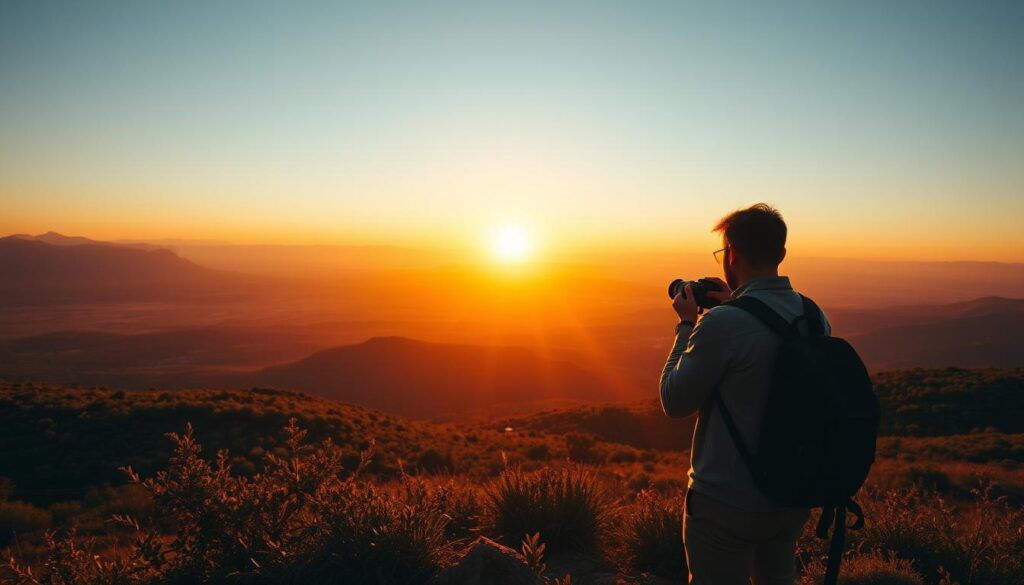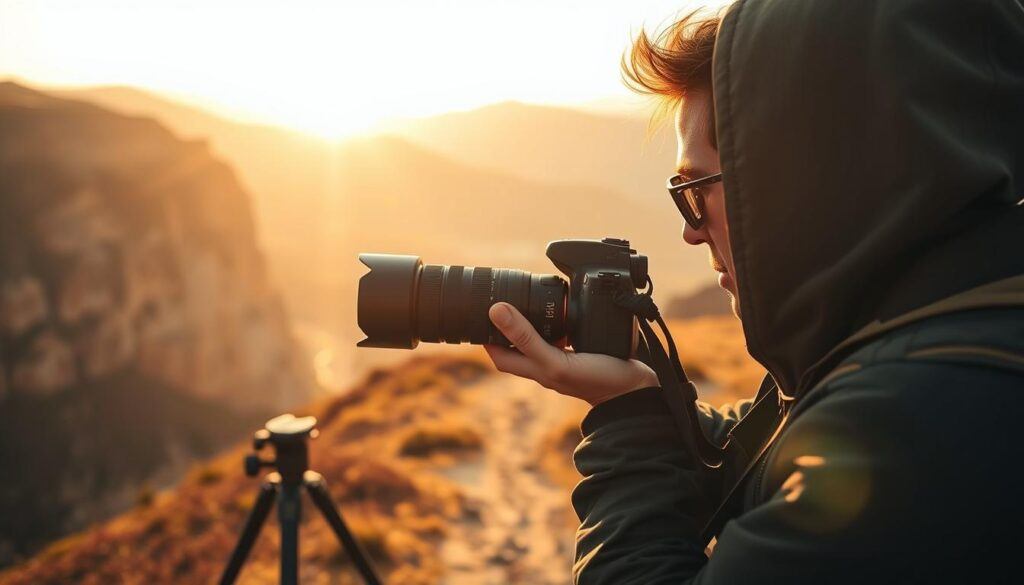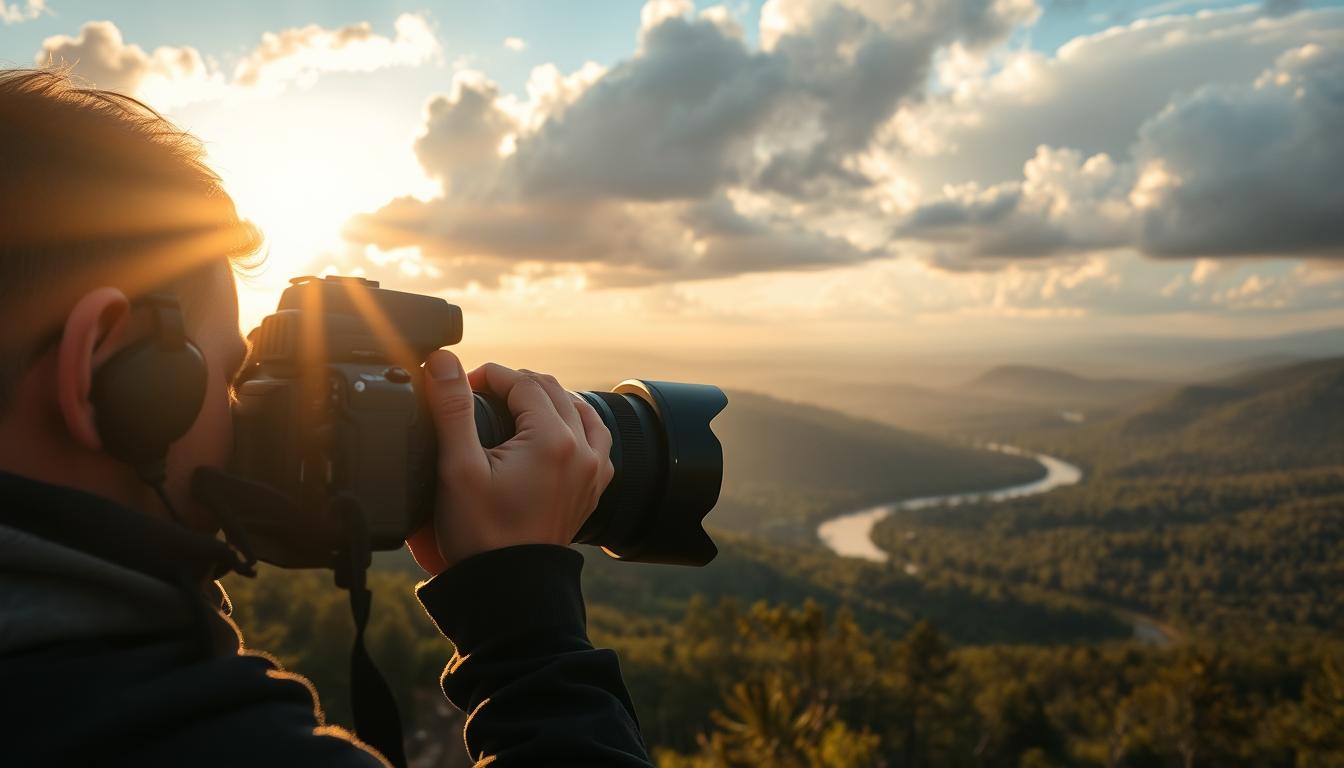Capturing the magic of your travels isn’t just about having the latest camera. It’s about seeing the world through a creative lens. And telling your unique story with every shot.
Whether you’re snapping photos on your phone or using a professional camera, mastering a few simple photography techniques can transform your snapshots into stunning memories that last a lifetime.
Ready to elevate your photography skills and capture your adventures like a pro? Explore the Wealthy Affiliate platform for more in-depth training and start your journey to becoming a skilled photographer.
Key Takeaways
- Master simple photography techniques to enhance your travel photos.
- Learn to tell a unique story through your photographs.
- Explore the Wealthy Affiliate platform for in-depth photography training.
- Transform your snapshots into lasting memories.
- Elevate your photography skills to capture adventures like a pro.
Understanding the Essentials of Travel Photography
Travel photography is more than just pointing a camera. It’s about capturing the essence of a place. As a beginner, knowing the basics can make your travel and photos better.
Why Travel Photography Is Different from Other Genres
Travel photography is unique because you shoot in new places with different lights and subjects. It’s not just about landscapes. It’s also about local cultures, people, and buildings. The key is to be versatile and prepared for anything.
Setting Realistic Expectations as a Beginner
As a beginner, it’s key to have realistic goals. Your first photos might not be perfect, and that’s fine. Practice and patience are key. Start by learning your camera’s basics and then try new things.
- Learn the basics of your camera or smartphone.
- Practice regularly before your trip.
- Research your destination to understand what to capture.
The Mindset for Capturing Memorable Travel Moments
Having the right mindset is key. Be open to new experiences and don’t be afraid to try new things. Engage with locals, try new foods, and explore off-the-beaten-path locations. This will make your trip better and give you unique photo chances.
Essential Travel Photography Gear for Beginners
Starting your travel photography journey means choosing the right equipment. Knowing what gear is essential can greatly improve your photos.
Camera Options That Won’t Break the Bank
You don’t need the most expensive camera to take great photos. Look into mirrorless cameras or high-end smartphones. Brands like Sony, Canon, and Samsung offer great quality without a high price.
Must-Have Accessories for Your Travel Kit
A good travel kit has more than just a camera. You’ll need:
- A durable camera bag for protection
- Extra batteries and memory cards to keep shooting
- A tripod for stable shots in low light
- A lens cleaning kit to keep your gear clean
Packing Light Without Sacrificing Quality
Traveling light is key, but so is having the right gear. Here are some tips:
Weight Distribution Tips
Spread the weight of your gear evenly to avoid strain. Wear your heaviest items, like your camera bag, to keep your luggage light.
Protection Solutions for Your Equipment
Use protective cases and lens pouches to keep your gear safe. For extra protection, consider a hard-shell case for your most valuable items.
| Accessory | Purpose | Recommendation |
|---|---|---|
| Camera Bag | Protection and Comfort | Look for padded, ergonomic designs |
| Tripod | Stability for Shots | Compact, lightweight models are ideal |
| Lens Cleaning Kit | Maintenance | Include a soft brush, cleaning solution, and microfiber cloth |
As Ansel Adams said, “You don’t take a photograph, you make it.” With the right gear and knowledge, you’re ready to make memorable travel photos.
Mastering Your Camera Settings on the Go
To improve your travel photography, you must know your camera settings. Learning these settings helps you take great photos, even when it’s hard.
Understanding Exposure Triangle for Travel Scenarios
The exposure triangle includes aperture, shutter speed, and ISO. Knowing how they work together is key to amazing travel photos.
- Aperture: Controls how much light gets in and affects depth.
- Shutter Speed: How long the shutter is open, which affects motion and blur.
- ISO: How sensitive the camera is to light, with lower ISOs for bright and higher for dark.
When to Use Different Shooting Modes
Your camera has many shooting modes for different situations.
- Manual Mode: You control everything, great for pros.
- Aperture Priority: Good for portraits to control depth.
- Shutter Priority: Best for capturing motion, like in sports or wildlife.
Setting Up Your Camera for Quick Adjustments
To adjust quickly, get to know your camera’s custom settings and shortcuts.
Mastering your camera settings lets you take amazing travel photos easily.
How to Take Stunning Travel Photos with Any Camera
Stunning travel photos are possible with any camera, from smartphones to professional ones. The secret is knowing your camera’s strengths and using the right techniques. This way, you can capture the beauty of your travels.
Maximizing Smartphone Photography Capabilities
Smartphones are now great for travel photos. To get the best from your smartphone, use the HDR feature for better tonal values. Also, try different angles to make your photos interesting. Apps with manual controls can also boost your skills.
Getting the Most from Point-and-Shoot Cameras
Point-and-shoot cameras are easy to carry and use for travel photos. To get the most out of them, know their limits, like in low light. Use their scene modes and zoom to capture more.
DSLR and Mirrorless Camera Advantages for Travelers
DSLR and mirrorless cameras offer better image quality and control. They have interchangeable lenses for different shots and manual controls for creative freedom. They may be bigger, but their quality and flexibility are worth it for serious photographers.
Using your camera’s strengths can greatly enhance your travel photos. “The camera is just a tool; the photographer is the one who captures the moment,” as
Ansel Adams once said
, highlighting the role of skill and creativity in photography.
Beginner’s Guide to Travel Photography Composition
Starting your travel photography journey? Learning about composition is essential. It’s the foundation of photography, making your travel photos stand out.
Rule of Thirds and When to Break It
The rule of thirds is a key photography rule. It divides your image into thirds, both ways. This creates nine parts. Place key elements on these lines or at their points for balanced photos.
But, knowing when to ignore this rule is also vital. Sometimes, symmetry or centering can make your photo more striking.
Using Leading Lines in Travel Scenes
Leading lines are a great tool in photography. They help guide the viewer’s eye. In travel shots, lines can be roads, shorelines, or building patterns. They add depth and movement to your photos.
Framing Techniques to Create Depth
Framing adds depth and context to your photos. It uses natural or man-made elements to frame your subject.
Natural Frames in Urban Environments
In cities, archways, doorways, or bridges make great frames. They isolate your subject and add layers to your image.
Creating Frames in Natural Landscapes
In nature, trees, rocks, or foliage frame your subject. These frames enhance your subject’s beauty and show scale.
| Composition Technique | Description | Example |
|---|---|---|
| Rule of Thirds | Dividing the image into thirds for balanced composition | Placing a mountain peak at an intersection point |
| Leading Lines | Using lines to guide the viewer’s eye | A road leading to a distant landmark |
| Framing | Using features to frame the subject | An archway framing a cityscape |
Mastering these techniques will boost your travel photography skills. You’ll capture more compelling images.
Mastering Light for Breathtaking Travel Images
Traveling and learning to work with light can make your photos amazing. The way light interacts with your subject changes the mood and atmosphere of your photos.
Working with Golden and Blue Hours
The golden hour and blue hour are magical times for travel photos. During these times, the light adds a special touch to your images. The golden hour, just before sunset, brings warm, vibrant colors. The blue hour, just after sunset, offers a cool, serene palette.

Handling Challenging Lighting Conditions
Not all travel photos are taken in perfect light. You might find yourself shooting in harsh midday sun or overcast skies. It’s important to know how to adapt to these conditions. For example, using polarizing filters can reduce glare and make colors pop on bright days.
Using Natural Reflectors While Traveling
Natural reflectors can add depth and interest to your photos. Water, glass, and even metal surfaces can reflect light. Trying out these elements can help you create unique, captivating images.
| Lighting Condition | Technique | Effect |
|---|---|---|
| Golden Hour | Warm Light | Vibrant Colors |
| Blue Hour | Cool Light | Serene Atmosphere |
| Harsh Midday Sun | Polarizing Filter | Reduced Glare |
Best Travel Photography Tips for Beginners: Capturing Different Subjects
Capturing different subjects while traveling needs both technical skills and cultural sensitivity. You’ll see many photography chances, like beautiful landscapes, lively street scenes, and detailed buildings.
Landscape Photography Techniques for Travelers
For landscapes, use a wide-angle lens to show the scene’s vastness. Try different angles and compositions, like shooting from low or high spots. Pay attention to lighting conditions, as the golden hour is often the best.
Street Photography: Capturing Local Culture
Street photography is about showing a place and its people’s essence. Be observant and patient, waiting for the perfect shot. Blend in with the surroundings to avoid attention, and always respect your subjects.
Architectural Photography on the Road
Photographing architecture means looking for interesting patterns, textures, and details. Use a tripod in low light. Try capturing buildings from unique angles for more interest in your photos.
Respectful Approaches to Portrait Photography While Traveling
Portrait photography while traveling needs thoughtfulness. Always ask permission before taking someone’s picture. Be respectful of local customs and traditions, and consider sharing your photos as a good deed.
| Subject | Tips | Best Practices |
|---|---|---|
| Landscape | Use wide-angle lens, experiment with angles | Pay attention to lighting, shoot during golden hour |
| Street | Be observant, patient, and respectful | Blend in, ask permission when necessary |
| Architecture | Look for patterns, textures, and details | Use a tripod, capture unique angles |
| Portraits | Ask permission, be respectful of customs | Offer to share photos, be considerate of local traditions |
By following these tips and being aware of your surroundings, you can capture a wide range of subjects while traveling. This will help you create a rich and compelling visual story of your adventures.
Easy Editing Tips for Travel Photos on the Go
Editing travel photos doesn’t have to be hard. Here are some simple tips to make your photos better on the go.
Mobile Editing Apps Worth Downloading
There are many mobile editing apps to choose from. Lightroom Mobile, VSCO, and Snapseed are great options. They let you tweak exposure, contrast, and color.
Quick Adjustments That Make a Big Difference
Small changes can make a big impact on your photos. Adjusting exposure and contrast can brighten them up. Use clarity and structure tools to add depth.
Organizing Your Photos During Your Trip
It’s important to keep your photos organized. Make folders on your device and sort by date or location. This makes finding photos easier.
Backup Strategies While Traveling
Always back up your photos to avoid losing them. Use cloud services like Google Drive or Dropbox. Also, carry portable storage devices.
Rating and Keywording Systems
Use a rating system to mark your favorites. Tag your photos with keywords for easy searching. This keeps your photo library tidy.
| Editing App | Key Features | Platform |
|---|---|---|
| Lightroom Mobile | Advanced editing tools, cloud sync | iOS, Android |
| VSCO | Presets, simple editing tools | iOS, Android |
| Snapseed | Detailed editing tools, selective adjustments | iOS, Android |
Travel Photography Tips for Solo Travelers
Traveling alone means you’re ready for anything and can capture every moment. You get to see your journey through your own lens, making it personal and meaningful.
Capturing Yourself in the Scene
Self-portraits can make your travel photos stand out. Use a tripod and timer, or ask someone to take your picture. Try different angles and setups to keep your photos interesting.

Safety First
When you’re alone, watch your surroundings, even when taking photos. Keep your gear hidden in crowded places. Listen to your gut and steer clear of anything that feels off.
Engaging with Locals
Talking to locals can make your photos unforgettable. Be kind and open, and always ask before snapping someone’s picture. It’s a great way to get amazing shots and learn more about where you are.
Overcoming Common Travel Photography Challenges
Travel photographers face many hurdles, like crowded places and changing weather. Knowing how to tackle these issues is essential for capturing amazing photos on your travels.
Dealing with Crowded Tourist Locations
Crowded areas can be daunting, but there are ways to get great shots. Try visiting famous spots early in the morning or late at night to miss the rush.
Tips for Crowded Locations:
- Use a wide-angle lens to capture the scene.
- Look for unique vantage points that can help you avoid crowds.
- Shoot in black and white to add a timeless feel to your photos.
Weather Challenges and How to Adapt
Weather can change quickly, and photographers need to be ready. Rain, fog, or bright sun can affect your photos, but they also offer special chances.
| Weather Condition | Photography Tips |
|---|---|
| Rain | Use a waterproof camera cover, and look for reflections in puddles. |
| Fog | Capture misty landscapes, and use the fog to create moody atmospheres. |
| Harsh Sunlight | Use a polarizing filter to reduce glare, and shoot during the golden hour for warm tones. |
Language Barriers and Photography Permission
Language differences can sometimes block your ability to ask for photo permission. Learning a few local phrases can make your interactions easier.
Also, being polite and using body language can help get permission to take photos, when talking to locals.
Taking Your Travel Photography to the Next Level
To improve your travel photography, you need both technical skills and creativity. As you visit new places, think about how to capture your experiences in a unique way.
Creating Photo Stories Instead of Random Shots
Enhance your travel photos by telling a story. Instead of random shots, aim to capture a narrative. This could be a local festival, a historical site tour, or daily community life.
“A picture is worth a thousand words”. A series of images can tell a powerful story. By focusing on a narrative, your photos become more engaging.
Developing Your Unique Travel Photography Style
Creating a unique style is key to standing out. Try new techniques like playing with light or experimenting with composition. Over time, you’ll find your best approach and develop a unique voice in your photos.
Learning Resources for Continuous Improvement
Improvement requires using learning resources. Wealthy Affiliate is a great platform for photographers. It offers training and tools to enhance your skills, from editing to composition.
Online Communities for Feedback
Online communities are great for feedback. Photography forums and websites can give you constructive criticism and new technique insights.
Recommended Courses and Workshops
Look into courses or workshops for travel photography. These can be online tutorials or hands-on sessions with experienced photographers. They offer both theory and practical experience.
Conclusion: Your Journey as a Travel Photographer
As you keep going on your travel photographer journey, remember that practice and patience are key. The tips and techniques from this article are a good start. But, the real learning comes when you’re out capturing the world’s beauty.
Keep trying out different styles and don’t be afraid to try new things. Review your photos, learn from your mistakes, and use those lessons for your next adventure. With time, you’ll find a unique way to show the world.
Your journey as a travel photographer is just starting, and this article’s conclusion is a new beginning. Stay inspired, keep practicing, and soon you’ll share your amazing travel photos with everyone.

